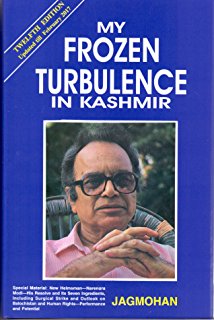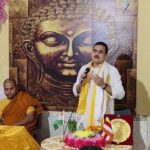Kashmir Narratives That Nail The Difference – II
- By : Anirban Ganguly
- Category : Articles

Jagmohan’s seven-point agenda to reinvent the State of Jammu & Kashmir is being implemented by a promising helmsman in Narendra Modi and that is a cause for great hope for the nation
In his seven-point programme delineated in the 12th edition of his seminal work on Jammu & Kashmir (My Frozen Turbulence in Kashmir), Jagmohan has no space for separatists, takes no soft line on Pakistan and on terrorism; he has seen the situation evolve from too close to hold some fancy utopian notions that will be bought over and be palatable to indigenous as well foreign human rights brigades.
He argues that each of these seven steps is being meticulously put into action by the Modi dispensation. In a detailed analysis of events and episodes, Jagmohan takes the reader through the last 33 months, narrating among other things, how at every step, Modi had reached out to the people. He writes of the ravaging floods of September 2014 — result of years of exploitation and faulty environmental planning in the State — when Omar Abdullah’s administration was clueless and “virtually paralysed from top to bottom” with Omar himself admitting at a certain point of time that “his Government went missing for a couple of days.”
Jagmohan reminds us as to how at the peak of the floods (September 2 to 5 2014), “Prime Minister Narendra Modi had an aerial survey. He described the damage to life and property as a national calamity and announced a financial aid of Rs 1,000 crore for relief and rehabilitation of the sufferers. Thousands of stranded families were rescued by the Indian Army, the Air Force and the Navy. About 30,000 troops were deployed in the State. By September 18, 2014, about 2,00,000 persons had been moved to safer places… All this was a great humanitarian service, a historic feat, of which any country could be proud…”
That year in October Modi spent a working Diwali in Srinagar, following up on the flood relief work that he had initiated earlier. Public memory is short, Chidambaram’s memory is even shorter and, therefore, he only speaks of the muscular approach, as if that was the only approach of the Modi dispensation.
He conveniently skirts the fact that the muscular approach was only limited to terrorists, to their sponsors, their protectors and their fronts. During his days at the helm of internal security, Chidambaram never displayed a muscular approach, either he did not have muscles or even if he possessed them did not have the temerity to display them, cowed down perhaps by the burden of international opinion, Pakistan’s belligerence and his own party’s perennially incoherent and inconsistent approach towards terrorism and separatism in the State.
Jagmohan analyses the formation of the BJP-PDP coalition and examines its working and the challenges that it had to face. Despite many challenges and difficulties, the coalition moved ahead and as Jagmohan writes, the BJP leadership, “both at the Centre and at the State lost no time in making it clear that issues of national security could not be trifled with…” He reminds his readers again how Modi’s development agenda for the State was at the forefront when in November 2015, while addressing a public rally, he announced a package of Rs 80,000 crore for radically augmenting the social and economic infrastructure of the State. “He underscored that the speedy development of the State would be the guiding star for his Government.”
Jagmohan also flags Modi’s emphatic call to the people and leaders of the State to work in a spirit and approach of “ekta, mamta, vikas and vishwas”, it was a new message the like of which was last heard when Atal Bihari Vajpayee was at the helm. Such a call was never heard during Chidambaram’s phase, it is only a confident and self-possessed leader who can display the gumption of giving such a clarion call and more importantly of standing by it.
Jagmohan exposes the human rights propaganda machine as well, he writes, “With regard to the allegations of large scale violations of human rights in Kashmir, the boot, for most part of it, would be found on the other leg. In the earlier chapters of this book, I have analysed a number of specific cases in which intentional falsification had been done to prop up the culture of radicalism, extremism and antagonism.
They show how brutal concoctions, culled out of brutalised mind, in an atmosphere brutalised by contrived feelings of victimhood are resorted to with impunity. While Pakistan and its valley-collaborators continue to spread their network of subversion and terrorism to serve their purpose of gobbling up Kashmir, it is the common folk who are put to all sorts of miseries.”
The one question that Jagmohan asks himself and then convincingly and unequivocally answers, is: “Are better days in store for the nation in which it could repair and renovate its leaky and rickety ‘boat of destiny’, retrofit it with new ‘timber’ and place its sail in the charge of a determined leader with expansive vision and penetrating mind?” His quest is to examine whether the “developments of the aforementioned period of 33 months hold out a promise of finding a new helmsman who could steer the ‘boat’ through stormy sea and turbulent winds and bring it safely to a calm and clean shore, from where a new journey, with a new mind motivation, could begin.”
In his detailed and masterly analysis of the last 33 months of a situation of which he knows the deep innards, like few do, Jagmohan veers round to the view that in the “courage, consistency and ‘resolute practicality’ that he has displayed Prime Minister Modi, is certainly the ‘promising helmsman.’ “From the above analysis of events of 33 months of Narendra Modi regime”, concludes Jagmohan, “it could be asserted, with a fair degree of reasonableness, that India which, in relation to the Kashmir issue, has been suffering, for years together, ‘trials and judgements’ of a turbulent sea, has, found a promising helmsman. He has shown the calibre to chart out a new sea-lane. He remains confident even when this lane is crossed by heavy winds and ominous clouds…”
While awaiting the 13th edition of Jagmohan’s opus, we must continue to trust his promising helmsman to steer us through and not be swayed by the buccaneers of a sinking ship. (Concluded).

















